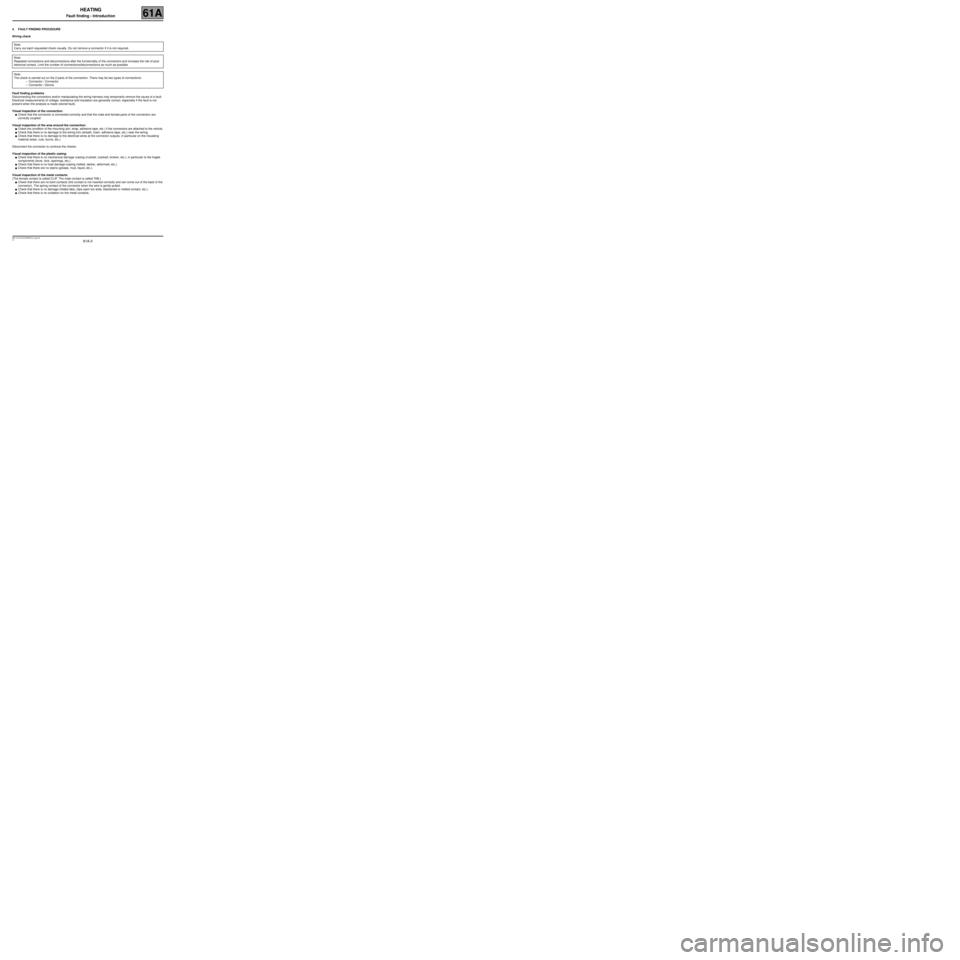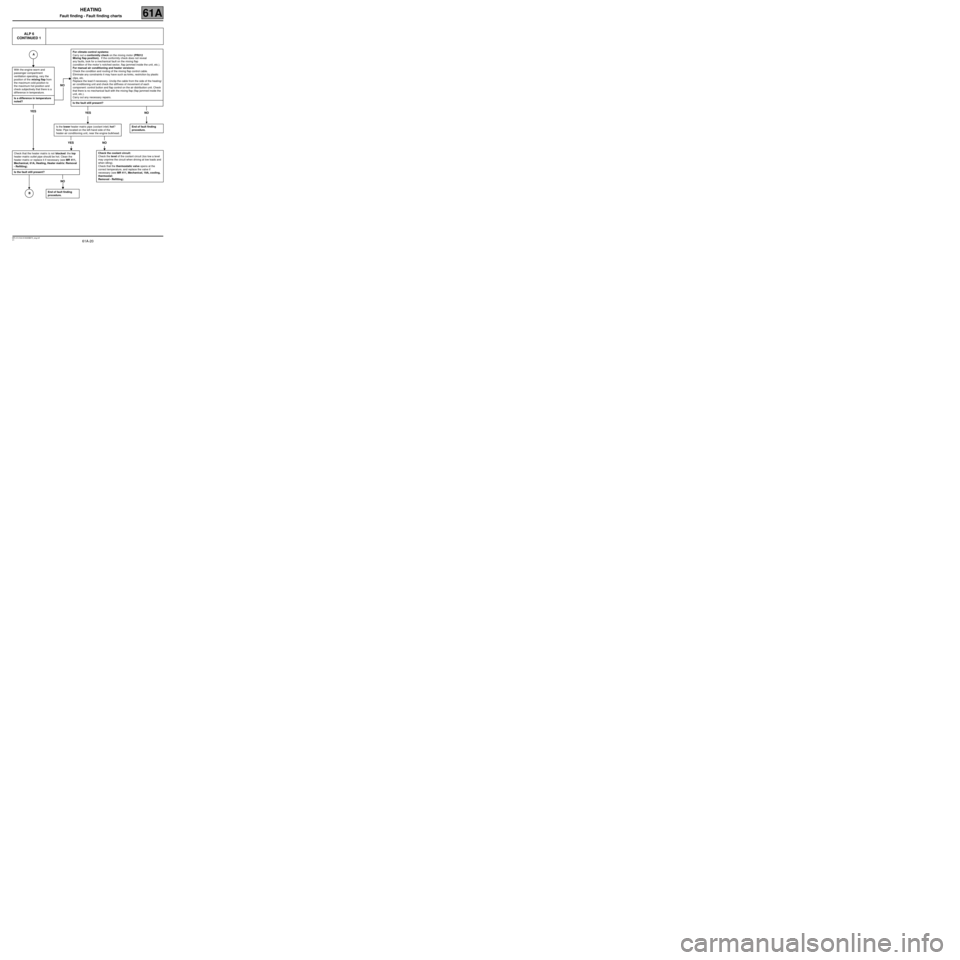lock RENAULT TWINGO RS 2009 2.G Heating And Air Conditioning - Heating Workshop Manual
[x] Cancel search | Manufacturer: RENAULT, Model Year: 2009, Model line: TWINGO RS, Model: RENAULT TWINGO RS 2009 2.GPages: 29
Page 3 of 29

61A-3
MR-413-X44-61A000$125_eng.mif
V1
HEATING
Fault finding - Introduction61A
4. FAULT FINDING PROCEDURE
Wiring check
Fault finding problems
Disconnecting the connectors and/or manipulating the wiring harness may temporarily remove the cause of a fault.
Electrical measurements of voltage, resistance and insulation are generally correct, especially if the fault is not
present when the analysis is made (stored fault).
Visual inspection of the connection:
●Check that the connector is connected correctly and that the male and female parts of the connection are
correctly coupled.
Visual inspection of the area around the connection:
●Check the condition of the mounting (pin, strap, adhesive tape, etc.) if the connectors are attached to the vehicle.
●Check that there is no damage to the wiring trim (sheath, foam, adhesive tape, etc.) near the wiring.
●Check that there is no damage to the electrical wires at the connector outputs, in particular on the insulating
material (wear, cuts, burns, etc.).
Disconnect the connector to continue the checks.
Visual inspection of the plastic casing:
●Check that there is no mechanical damage (casing crushed, cracked, broken, etc.), in particular to the fragile
components (lever, lock, openings, etc.).
●Check that there is no heat damage (casing melted, darker, deformed, etc.).
●Check that there are no stains (grease, mud, liquid, etc.).
Visual inspection of the metal contacts:
(The female contact is called CLIP. The male contact is called TAB.)
●Check that there are no bent contacts (the contact is not inserted correctly and can come out of the back of the
connector). The spring contact of the connector when the wire is gently pulled.
●Check that there is no damage (folded tabs, clips open too wide, blackened or melted contact, etc.).
●Check that there is no oxidation on the metal contacts. Note:
Carry out each requested check visually. Do not remove a connector if it is not required.
Note:
Repeated connections and disconnections alter the functionality of the connectors and increase the risk of poor
electrical contact. Limit the number of connections/disconnections as much as possible.
Note:
The check is carried out on the 2 parts of the connection. There may be two types of connections:
–Connector / Connector
–Connector / Device
Page 20 of 29

61A-20
MR-413-X44-61A000$875_eng.mif
V1
HEATING
Fault finding - Fault finding charts61A
ALP 6
CONTINUED 1
With the engine warm and
passenger compartment
ventilation operating, vary the
position of the mixing flap from
the maximum cold position to
the maximum hot position and
check subjectively that there is a
dif ference in temperature.
Is a difference in temperature
noted?
YES
NO
For climate control systems:
Carry out a conformity check on the mixing motor (PR012
Mixing flap position). If the conformity check does not reveal
any faults, look for a mechanical fault on the mixing flap
(condition of the motor ’s notched sector, flap jammed inside the unit, etc.).
For manual air conditioning and heater versions:
Check the condition and routing of the mixing flap control cable.
Eliminate any constraints it may have such as kinks, restriction by plastic
clips, etc.
Replace the lead if necessary. Unclip the cable from the side of the heating/
air conditioning unit and check the stiffness of movement of each
component: control button and flap control on the air distribution unit. Check
that there is no mechanical fault with the mixing flap (flap jammed inside the
unit, etc.).
Carry out any necessary repairs.
Is the fault still present?
YES NO
Is the lower heater matrix pipe (coolant inlet) hot?
Note: Pipe located on the left-hand side of the
heater-air conditioning unit, near the engine bulkhead.
YES NO
End of fault finding
procedure.
Check that the heater matrix is not blocked: the top
heater matrix outlet pipe should be hot. Clean the
heater matrix or replace it if necessary (see MR 411,
Mechanical, 61A, Heating, Heater matrix: Removal
- Refitting).
Is the fault still present?
NO
Check the coolant circuit:
Check the level of the coolant circuit (too low a level
may unprime the circuit when driving at low loads and
when idling).
Check that the thermostatic valve opens at the
correct temperature, and replace the valve if
necessary (see MR 411, Mechanical, 19A, cooling,
thermostat:
Removal - Refitting).
End of fault finding
procedure.
A
B